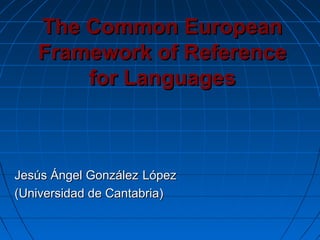
cefr introduction
- 1. The Common EuropeanThe Common European Framework of ReferenceFramework of Reference for Languagesfor Languages Jesús Ángel GonzálezJesús Ángel González LópezLópez (Universidad de Cantabria)(Universidad de Cantabria)
- 2. The Common European Framework for Languages: Learning, Teaching, Assessment. • Council of EuropeCouncil of Europe 2001: European Year of Languages2001: European Year of Languages ““The Common European Framework provides aThe Common European Framework provides a common basiscommon basis for the elaboration of languagefor the elaboration of language syllabuses, curriculum guidelines, examinations,syllabuses, curriculum guidelines, examinations, textbooks, etc. across Europe...textbooks, etc. across Europe... The CommonThe Common European Framework is intended toEuropean Framework is intended to overcome theovercome the barriersbarriers to communication among professionalsto communication among professionals working in the field of modern languages arising fromworking in the field of modern languages arising from the different educational systems in Europe.the different educational systems in Europe. Common language, common levels, common degrees andCommon language, common levels, common degrees and certificatescertificates Political objectives: mobility, cooperation, integration.Political objectives: mobility, cooperation, integration. Plurilingualism and multiculturalismPlurilingualism and multiculturalism General context: competence learning, (Bologna Process)General context: competence learning, (Bologna Process)
- 3. From Europe to the WorldFrom Europe to the World
- 4. 1. Horizontal description of languages: An action-oriented approach “The approach adopted here, generally speaking, is an action-oriented one in so far as it views users and learners of a language primarily as ‘social agents’, i.e. members of society who have tasks (not exclusively language-related) to accomplish in a given set of circumstances, in a specific environment and within a particular field of action”
- 5. Horizontal description of languages: - Teaching and Learning through communicative activities: - Reading - Listening - Writing - Speaking - Interaction - Mediation - Description based on positive elements - Skills-based teaching and assessment - Long-life learning - Autonomous learning - Flexible framework
- 6. The CEF The Language user/ learner The Context of Language use Communicative language competences General competences Assessment = How successful is the encounter? Illustrative scales Teaching and learning = How to enrich the competences? Common European Framework of Reference (CEF) Reception Production Spoken text Written text Real- life task Pedagogic task Test task Domain: Personal Public Occupational Educational Interaction Mediation
- 7. Communicative CompetenceCommunicative Competence ““Competence/Performance” (Chomsky): innate knowledge ofCompetence/Performance” (Chomsky): innate knowledge of the language vs. real use of the language in particularthe language vs. real use of the language in particular situations.situations. ““Communicative competence” (Hymes, 1971): rules of usageCommunicative competence” (Hymes, 1971): rules of usage of the language that allow the speaker to apply the grammarof the language that allow the speaker to apply the grammar rules, considering the socio-cultural reality.rules, considering the socio-cultural reality. Canale-Swain: communicative competence subdivided into:Canale-Swain: communicative competence subdivided into: • Grammatical competence: Linguistic codes, Words andGrammatical competence: Linguistic codes, Words and rulesrules • Strategic competence: verbal and non-verbal strategiesStrategic competence: verbal and non-verbal strategies used to overcome communication difficultiesused to overcome communication difficulties • Sociolinguistic competence: adapting the language to theSociolinguistic competence: adapting the language to the context (speaker’s types and intentions)context (speaker’s types and intentions) • Discursive competence: responsible for internal cohesionDiscursive competence: responsible for internal cohesion and unity, how words and sentences are combined to makeand unity, how words and sentences are combined to make up a textup a text • Sociocultural competence (Van Ek): sociocultural referentsSociocultural competence (Van Ek): sociocultural referents • Social competence (Van Ek): motivation, confidence,Social competence (Van Ek): motivation, confidence, empathyempathy
- 8. General competences •Declarative knowledge (“savoir”) •Skills and know-how (“savoir faire”) •Existential competence (“savoir être”) •Ability to learn (“savoir apprendre”) 2. Pragmatic Competences •Discourse competence •Functional competence 1. Linguistic competences •Lexical •Grammatical •Semantic •Phonological •Orthographic •Orthoepic 3. Sociolinguistic competence •Linguistic markers of social relations •Politeness conventions •Expressions of folk visdom •Register differences •Dialect and accent Strategies •productive •receptive •interactive •mediating
- 9. BICS/CALP (Cummins)BICS/CALP (Cummins) - BICS: Basic Interpersonal CommunicationBICS: Basic Interpersonal Communication Skills (Basic Competences”)Skills (Basic Competences”) - CALP: Academic Language (“LearntCALP: Academic Language (“Learnt Competences”)Competences”) - There are somenatives who are never able toThere are somenatives who are never able to use adequately some academic competencesuse adequately some academic competences It is important to balanceIt is important to balance the two types ofthe two types of competences incompetences in assessmentassessment (problem in some B2-C1(problem in some B2-C1 exams)exams)
- 10. 2. Vertical description: Levels A. Basic User: A1-A2 A1 (Access): The most basic level which can be defined. Very simple interaction. In a few months. A2 (Waystage): Intermediate step towards the threshold level. Social functions.
- 11. 1.2. Vertical description: Levels B. Independent User: B1-B2 B1 (Threshold level): User who crosses the metaphoric threshold and is able to travel to a foreign country and behave independently in daily situations (public transport, travel agency). 375 hours for English. Ciclo Elemental E.O.I. B2 (Advanced Level): User who is able to argue and manage in social exchanges without imposing tension. Also able to correct mistakes.
- 12. 1.2. Vertical description: Levels C. Competent User: C1-C2 C1 (Effective Proficiency): Not just independent, but competent too. Wide range of vocabulary and grammar. Able to use the language with flexibility and efficiency for social, academic and professional purposes. C2 (Mastery): brilliant user, able to transmit subtle shades of meanings and to use idioms and colloquial language. Not a native.
- 13. A1 A2 B1 B2 C1 C2 Basic user Independent user Competent user
- 14. The CEF levels A1 A2 B1 B2 C2Basic user Independe nt user Proficient user Basic needs and very familiar topics in simple language Social functions and short monologue Treshold level for coping with everyday life Regular relationships with native speakers Correct, accurate and appropriate language use in demanding contexts Fluent, spontaneus communication in a broad range of language C1
